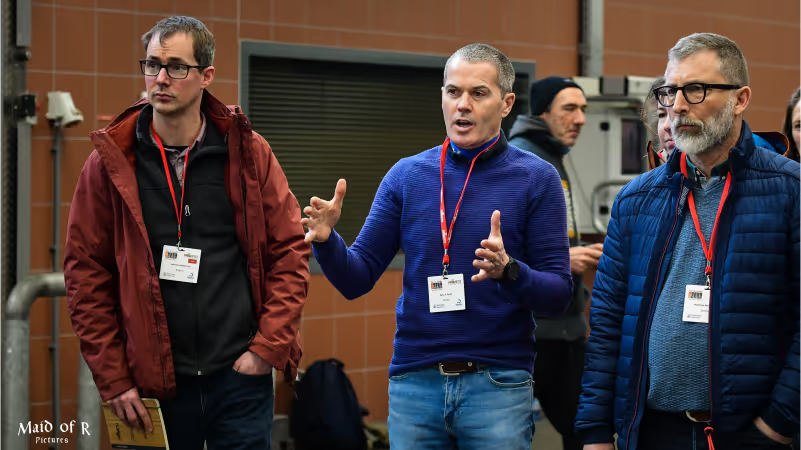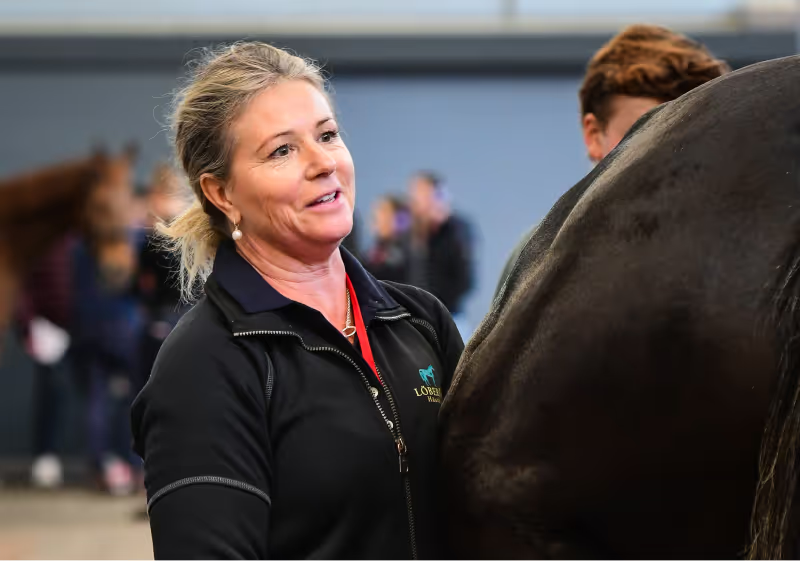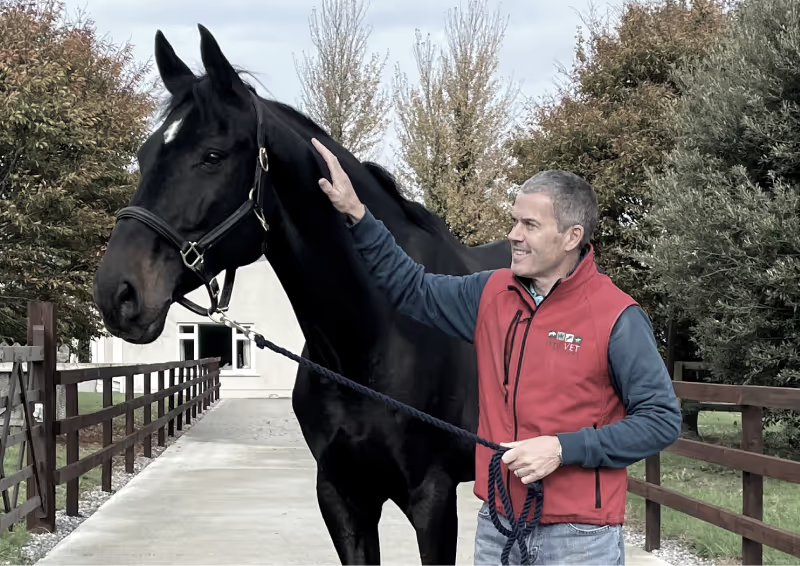
29 January 2024
Jumping Amsterdam plays host to the annual Sport Horse Veterinary Congress and is the place where international sport horse vets meet. This year, the much-appreciated pre-congress practical day focused on the intricacies of the pre-purchase exams when the stakes are high. Irish team vet Marcus Swail, FEI vet Lisa Lidbeck and German team vet Marc Koene were some of the instructors at this collegial event.
Marc: We had fun! It's a very nice format, looking at horses together. It was a mix of dressage horses and show jumpers. This is a gathering of very experienced people, and everyone has their way of doing things. Marcus had the wrong leg, for instance!
Marcus: I thought we were leaving that argument for later, but I can see we're getting straight into it! I got two bad pieces of advice from Marc yesterday. One was that the horse was lame left hind, the other was that I should see more dressage horses! Joking aside, the purpose of the day, I think, can be summed up as information sharing. A day like this is a way for colleagues to understand what other colleagues and customers expect.
The thing about pre-purchase exams is that there are cultural differences. In Ireland, it's common for pre-purchase examinations not to be seen ridden. In my clinic, probably 30-40 percent are ridden, but that's because those horses are for export to the UK or US, and that is what's expected in those markets.
Or take Germany, where it's not permitted to longe a horse in a hard circle on the end of a rope. Yesterday, we looked at many horses with handlers running around the circle.

Marcus: It's very interactive.
Lisa: It's a very interactive event in a relaxed environment —a lot of questions and good discussions.
Marcus: I was a little apprehensive about what the day would be like as this is new to me. But the atmosphere at Jumping Amsterdam is really friendly and collegial.
Marc: Yes, and even on a scientific level, it is one of the best in the world at the moment.
Lisa: The problem with pre-purchase exams is that some horses may have what you would flag as an issue, but they compete at the highest level. At the same time, a similar issue in another horse may be a problem. Getting the complete picture together is essential for presenting the buyer and seller with a risk analysis. That's the biggest challenge.
Marc: It's a one-time, isolated assessment. There's a lot of money and emotions involved – and as a vet, you are liable. So, it's a hot topic. A lot of vets stopped doing pre-purchases because of this liability issue.

Marcus: One of the purposes of yesterday was for everyone to see how others approach the pre-purchase exam. And to get a sense of finding the balance. You cannot be looking for the perfect horse because then you won't be recommending anything for purchase. But at the same time, you can't be too relaxed in your opinion, because that may be associated with significantly increased risk. The more we share information and look at how everyone else does it, the more consistent our view will be.
As Marc said, pre-purchase exams at this level are challenging, and many vets don't like doing them.
Marc: Well, I'm already using it. However, I think more research is needed before it becomes part of the pre-purchase examination protocol.
Marcus: I don't use it as part of my PPE routine, but to reinforce my statements. The strength of Sleip is it's very good at detecting those subtle lamenesses, like a 15-20 per cent asymmetry that is just borderline for what our eyes can pick up. That's where I like to use it!
Marcus: I have had circumstances where I've told the seller, "Listen, it's not a whole lot, and it comes and goes, but this horse is just consistently lame". The seller will say they cannot see what I'm talking about. And that's when I bring the objective system out. And, of course, one of the things I have always liked about Sleip is that it always agrees with me.
Marc: And it's super documentation, with the videos and so on.
Marcus: The second instance I'll use the gait analysis system is following an exam like that when the seller typically goes home, calls you back in a week and says, "The farrier's been here, and the horse is perfect".
That's when I send them the link from Sleip to record and have them take the horse out and trot it up and down. Then the data is processed, and if the leg is still yellow or orange in the app summary, I'll say, "No, it needs to be better than that."
Marc: So you are using it for PPEs!
Marcus: Yes, I'm using it to reinforce some of my statements, not as the full breadth of my documentation.
Marc: I do the same. It's a reinforcement, especially when you have a negative outcome.
Marcus: We're back to the risk thing again. If you only have information from that one day, it's much more difficult to predict what the future risk is going to be. If you have data from one year or two years documented, and it's stable, you're in a better position to provide a risk assessment.
Marc: Yes, if you have medical records and the show record, or if you've taken pictures every six months or indeed this longitudinal monitoring - that brings trust.
Lisa: Just like the things that show up on X-rays, horses usually have the same moving pattern over many years. For instance, they can have a small degree of asymmetry on the left front, which is part of their usual sound pattern. If you have that documented in an objective way, that would be a good thing to have when doing a pre-purchase.
I think all the vets here have a gut feeling if a horse is "used" to a lameness. You can usually tell the difference from something more acute.
Marcus: Yes, you do get that feeling.
Marc: I think I know what you mean. And this gut feeling is difficult to sell!
Lisa: Yes, it is! And that's what I mean; having that documented makes a difference. Having longitudinal data would help calibrate the risk, rather than just the one Sleip measurement on the day.
Lisa: If you have this objective way of looking at lameness, you can share that among vets. Yesterday, just for fun, I asked the group what degree of lameness they would put on a horse on the 1-5 lameness scale, with answers ranging from 1 and 1.5 to 2 and 2.5.
Lisa Lidbeck's words wrap up our conversation on the pitfalls of pre-purchase exams. We thank her, Marc Koene, and Marcus Swail for their time and for sharing their experiences with us!

Team vet for the German Dressage Team and co-owner of Veterinary Clinic Lüsche

Team vet for the Irish Showjumping, Eventing and Dressage teams and founder of EquiVET Ireland, president of Irish Equine Veterinary Association (IEVA)

Swedish equine veterinarian and lameness specialist, FEI vet level 4, founder of Löberöds Hästklinik
